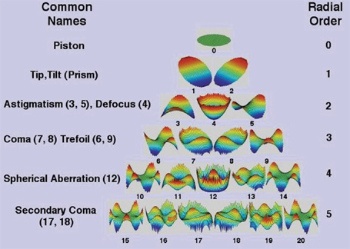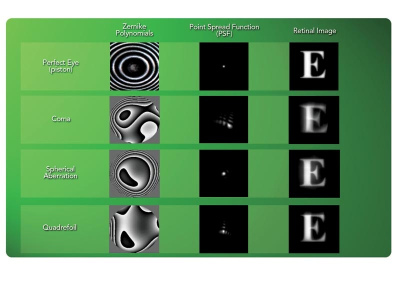|
What are High Order Aberrations?
High Order Aberrations: It is no surprise that the human eye is not a perfect optical system but suffers from many high order aberrations that degrade the retinal image quality. Light aberration causes blurred vision. An aberration simply means anything that prevents light from traveling in a straight line. In other words, an aberration causes the ray of light to be misdirected from its desired image point. Zernike Polynomials are derived by mathematically converting the wavefront error created by a specific aberration and transforming it into a three-dimensional model that mimics the shape of the aberration. 
Even though over 65 total aberrations up to the eighth order have been identified, the human eye is able to perceive distortion effects only up to the fifth or sixth order. Clinically significant High Order Aberrations (HOA) can degrade vision in spite of full correction being used for defocus (Myopia, Hyperopia) and Astigmatism. There are two main types of light aberrations:
Second-Order Aberrations: These include: lenses to correct for Myopia, Hyperopia, Presbyopia, and Astigmatism. Another way to demonstrate how your vision may be distorted by aberrations is using a tool known as a Point Spread Function (PSF), which uses another mathematical calculation. Basically, when a point of light passes through the eye, the aberration(s) that eye possesses will disperse or spread the beam, causing the point to blur. The point of light will take on a characteristic appearance when it hits the retina, depending on the aberration(s) present. See the point spread function chart below.
What causes HOA?
Any condition that affects the optics of the eye will result in changes in HOA. These include, but are not limited to: Even conditions that result in irregular Retina surfaces may create High Order Aberrations such as: Pupil issues may be seen in: What are symptoms of HOA?
Uncorrected HOA may cause specific bothersome symptoms in vision such as: How are HOA measured?
High Order Aberrations are measured using an aberrometer. There are several commercial brands available which work on the same general concept. In a nutshell, two or more parallel beams of light are passed through the eye and then a method is used to measure the extent to which those beams cease to travel in a visually optimal path. Complex mathematical formulas then predict aberrations based on the altered angle of those beams. The most commonly used method today is known as the Shack-Hartmann Method, which is used in several wavefront refractive surgery platforms. In this technique, a bright beam of light is projected into the retina and reflects back out through the eye. The exiting beam then passes through an array of lenses (called lenslets) where it is split into many tiny beams that project spots of light on a digital camera. The displacement of these spots corresponds to the amount of aberration. The commercial brands available can give the eye care provider much more information about each patient than he or she ever had previously. For example, there is a brand of wavefront aberrometer that incorporates auto refraction (estimating the prescription of the patient; i.e. calculating the low-order aberrations), corneal topography (showing a map of the corneal surface), keratometry (measuring corneal curvatures), pupillometry (measuring the distance between the pupils), along with measuring High Order Aberrations. How can HOA be corrected?
HOA can be corrected with spectacle glasses, for example. Some contact lenses companies are touting that their lenses help correct High Oder Aberrations. In the area of spectacle correction, there is a commercial brand aberrometer available which is a high resolution system measuring more than 11,300 points within a 6 mm pupil diameter. Benefits of using this equipment include: |





